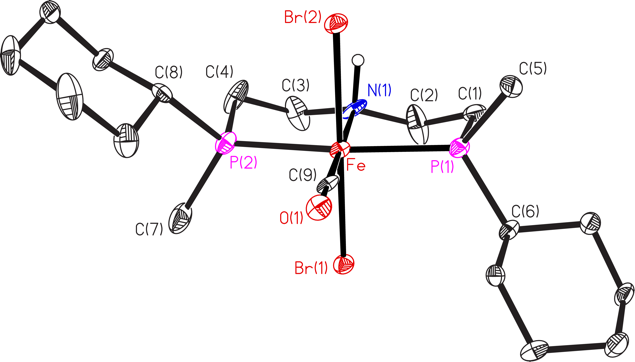Chiral Iron(II) PN(H)P Pincer Complexes for the Asymmetric Hydrogenation of Ketones
Iron(II) complexes of PN(H)P pincer ligands are active catalysts in the direct hydrogenation of ketones,1 and also enantioselective versions appeared.2,3 Based on our long-term experience in the synthesis of chiral phosphine ligands, we prepared enantiopure, P-stereogenic, C2-symmetric PN(H)P pincer ligands and their iron(II) complexes, which will be tested in the asymmetric hydrogenation of ketones.

The enantiopure pincer ligand a bearing cyclohexyl and methyl substituents on each P atom was obtained in a 7-step synthesis from PCl3. Starting from the iron(III)‑free iron precursor 1 and ligand a, the blue precatalyst [FeBr2(CO)(a)] (2a) formed immediately upon setting the reaction mixture under CO atmosphere (1.1 bar). Complex 2a (see X-ray structure below) was converted into the hydride 3a, which showed good activity but low selectivity (22% ee) in the hydrogenation of acetophenone at room temperature in toluene. We are currently preparing ligands with sterically more demanding dialkylphosphine donors (such as b) and arylalkylphosphine donors (such as c) to improve the enantioselectivity.

[1] E. Alberico, P. Sponholz, C. Cordes, M. Nielsen, H. Drexler, W. Baumann, H. Junge, M. Beller, Angew. Chem. Int. Ed. 2013, 52, 14162.
[2] S. A. M. Smith, P. O. Lagatidis, A. Lüpke, A. J. Lough, R. H. Morris, Chem. Eur. J. 2017, 23, 1.
[3] A. Zirakzadeh, K. Kirchner, A. Roller, B. Stöger, M. Widhalm, R. H. Morris, Organomettalics 2016, 35, 3781.